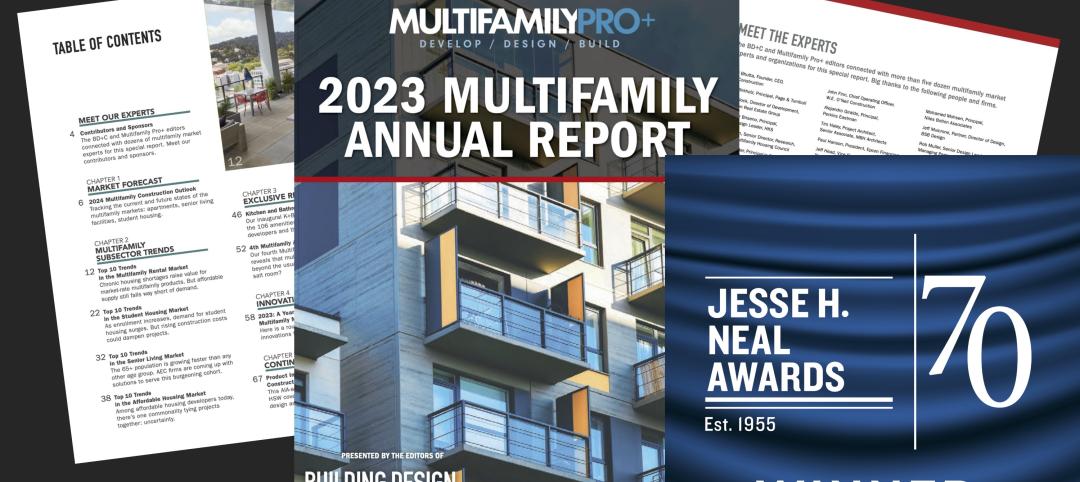 |
For years, precast concrete has been viewed as a mass-produced product with no personality or visual appeal—the vanilla of building materials.
Thanks to recent technological innovations in precast molds and thin veneers, however, that image is changing. As precast—concrete building components that are poured and molded offsite—continues to develop a vibrant personality all its own, it is playing an increasingly vital role in the building industry, as a nearly completed project at Pennsylvania State University illustrates.
“Precast is just coming into its own now,” says Bill Wolfford, vice president of Sponaugle Construction Services, State College, Pa., the construction manager for Crocker-West, a 121,000-sf, $16.5 million Applied Research Lab being built on a 6.3-acre site at Pennsylvania State University's main campus. Aside from a window curtain wall, the building is being constructed entirely of precast elements.
 |
| The $16.5 million Crocker-West Advanced Research Lab will seek LEED Gold certification when it’s completed in December. |
“The way manufacturers have been able to incorporate technology into molds to produce architecturally pleasing panels has gotten more people interested day by day,” says Wolfford. “Precast has come a long way in the last few years. It makes sense now.”
Scott Smith, the building's designer and a principal at local firm Civilsmith Engineering, Inc., says that one of the inherent advantages of a total precast building is its efficiency and the “tremendous time savings” it affords the construction schedule.
Using precast enabled Crocker-West to be constructed in phases, each consisting of a different piece of the total structure, along with a parallel construction schedule. This approach has enabled various trades to work concurrently on discrete sections of the structure. For example, while the roof and floors were in place in the first phase and workers were starting to frame walls, phase five was still just an open shell.
 |
| Designer Scott Smith of Civilsmith Engineering created a custom 30-foot module in which to cast most of the project’s 1,200 pieces, which are slightly smaller than in most precast construction. |
“The building just goes together like a jigsaw puzzle,” says Smith. “It allows trade workers to be in the building sooner, since the building goes up three stories at a time, one section at a time.”
The interior structure and exterior shell were erected in only eight-and-a-half weeks. Since everything is pre-coordinated, erecting the precast panels involved only one building trade, making the work flow a lot smoother.
Only four weeks into the job, the Building Team was able to roof completed portions and begin installing components such as windows and rough-in mechanical details. “This construction schedule is absolutely unattainable by other methods,” says Smith.
The use of welded connections instead of grouted ones allowed the structure to go up even faster than traditional total precast projects by eliminating the need to slow the work down to heat the grout. Elements such as light fixtures, conduit, and HVAC openings were also cast into the panels, saving subcontractors time.
On the main building, precast panels serve four functions: exterior façade, structural component, fireproofing, and insulation. The panels have an insulation value of R-28, compared with about R-13 for conventional construction.
Crocker-West is already well ahead of its originally projected 45-week construction schedule and is on track for completion in December, five weeks ahead of schedule. Without precast, a project of this size might require another six to eight months of construction time, according to Smith.
Heightened aesthetics
Strategic pre-planning in the precast design process has also resulted in enhanced aesthetics for the project.
Repetition—the key to efficiency and cost-effectiveness in precast—enabled Smith to incorporate ornate pieces in the project without blowing the budget. Many of the project's 1,200 pieces were cast on a single, 30-foot module of Smith's creation. He also designed a relatively expensive mold for an ornate cornice, then used the mold for 40 separate pieces that are spread across the entire building, greatly reducing the unit cost of each piece.
 |
| API, a division of US Concrete Precast Group, did all the precast work, including panels that emulate the look of limestone. Using precast will chop five weeks off the 45-week construction schedule. |
The Building Team also used new mold technology to employ dyed architectural precast on Crocker-West's exposed interior columns, which were sandblasted to provide texture. This technique eliminated the need to wrap the columns in fireproofing or to paint and maintain them. Other pieces utilized a kind of limestone-look liner or thin brick accents built into the initial design. API, a US Concrete Precast Group company, did all the precast work.
Careful scheduling and delivery of precast panels and hollow-core floor planks (from Nitterhouse Concrete Products, Chambersburg, Pa.) reduced the need for onsite storage, since the precast was off-loaded directly onto the building rather than having to be stored onsite.
While some precast project designs typically seek to minimize costs by limiting the number of precast pieces, Smith realized that trimming construction time would yield even greater savings. Instead of following a typical precast design that calls for erection of large vertical panels, Crocker-West was constructed horizontally, story by story, using slightly smaller pieces but more of them.
“Total precast offers a lot of benefits that might not be outwardly obvious,” says Smith, who with partner Mike Coyle formed C2S, a limited partnership which is developing the property for Penn State on a leaseback basis. Since Crocker-West is a prevailing wage project, less onsite work has reduced labor costs. A compressed construction schedule will result in a quicker revenue stream and lower construction interest costs for C2S.
Sustainable design benefits, too
Precast construction is also helping the Building Team toward its goal of a LEED Gold rating.
Severe flooding in the area prompted the township to impose rigorous site restrictions: absolutely no net gain in drainage runoff rate or volume from the 6.3-acre site for a 100-year flood event. To meet this requirement, Smith designed a gigantic underground precast cistern to capture runoff and control infiltration.
The 130-foot-long, 12x12-foot concrete tank can hold 138,000 gallons of runoff, which will be filtered, treated with ultraviolet light, and reused as graywater for flushing toilets in the building. The cistern sits entirely below ground and supports the weight of the parking area and landscaping. One of its walls is formed by the exterior load-bearing wall of the building.
Despite its many benefits, precast is not the answer for every project. “It's a very cost-competitive solution for large, multi-story buildings or big, single-story buildings,” says Sponaugle Construction's Wolfford.
To take full advantage of precast's benefits, the building needs to have lots of repetition in order to be able to reuse molds. Wolfford also recommends that a precast specialty engineer be consulted from the very start of the project to save on pre-design costs, which are critical to overall cost savings.
With the right project, though, precast can be a contactor's dream come true. “I'm a huge fan of total precast now,” says Wolfford, who had never done a precast job before Crocker-West. “It makes my life a lot easier.”
Related Stories
Resiliency | Sep 3, 2024
Phius introduces retrofit standard for more resilient buildings
Phius recently released, REVIVE 2024, a retrofit standard for more resilient buildings. The standard focuses on resilience against grid outages by ensuring structures remain habitable for at least a week during extreme weather events.
Contractors | Aug 21, 2024
The average U.S. contractor has 8.4 months worth of construction work in the pipeline, as of July 2024
Associated Builders and Contractors reported today that its Construction Backlog Indicator held steady at 8.4 months in July, according to an ABC member survey conducted July 22 to Aug. 6. The reading is down 0.9 months from July 2023.
Building Team | Aug 13, 2024
Don't miss out! 2024 Women in Residential+Commercial Construction Conference, September 18-20, Phoenix
This annual conference gathers 300+ women in construction for three transformative and education-rich days packed with industry speakers, AIA-accredited sessions, breakout education tracks, roundtable discussions, panels, and networking events.
Building Team | Jul 3, 2024
So you want to get published: What’s next?
In the AEC industry, securing media attention is no longer a niche endeavor but an essential component of a holistic marketing strategy.
Building Team | Apr 30, 2024
Building Design+Construction wins a 2024 Jesse H. Neal Award for editorial excellence
The editors of Building Design+Construction and Multifamily Pro+ were honored last week with a 2024 Jesse H. Neal Award for editorial excellence for their work on the “2023 Multifamily Annual Report.” The 76-page special report, published last October, won the Neal Award for Best Subject-Related Package.
Engineers | Sep 8, 2023
Secrets of a structural engineer
Walter P Moore's Scott Martin, PE, LEED AP, DBIA, offers tips and takeaways for young—and veteran—structural engineers in the AEC industry.
Giants 400 | Aug 30, 2023
Top 75 Engineering Firms for 2023
Kimley-Horn, WSP, Tetra Tech, Langan, and IMEG head the rankings of the nation's largest engineering firms for nonresidential buildings and multifamily buildings work, as reported in Building Design+Construction's 2023 Giants 400 Report.
Building Team | Aug 28, 2023
Navigating challenges in construction administration
Vessel Architecture's Rebekah Schranck, AIA, shares how the demanding task of construction administration can be challenging, but crucial.
Giants 400 | Aug 22, 2023
2023 Giants 400 Report: Ranking the nation's largest architecture, engineering, and construction firms
A record 552 AEC firms submitted data for BD+C's 2023 Giants 400 Report. The final report includes 137 rankings across 25 building sectors and specialty categories.
Senior Living Design | Aug 7, 2023
Putting 9 senior living market trends into perspective
Brad Perkins, FAIA, a veteran of more than four decades in the planning and design of senior living communities, looks at where the market is heading in the immediate future.
















